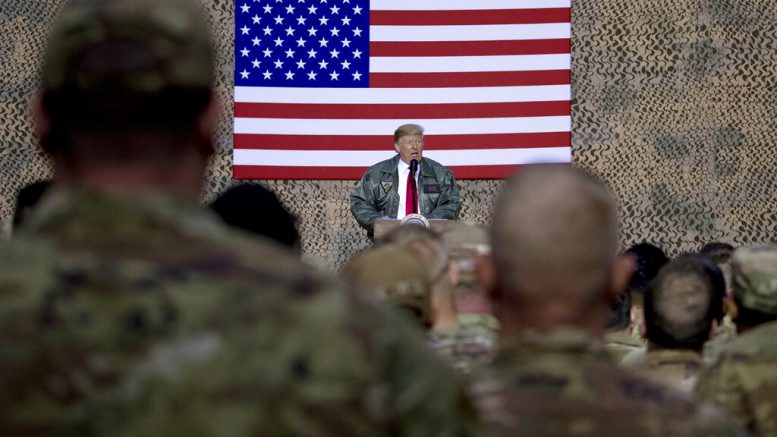TEHRAN, Iran (AP) — Iran struck back at the United States early on Wednesday for killing its most powerful military commander, firing a barrage of ballistic missiles at two Iraqi military bases that house American troops in what the Iranian supreme leader said was a “slap” against America’s military presence in the region.
The retaliatory move is another dangerous escalation that could draw the region deeper into turmoil, despite insistence by Washington and Tehran that neither side wants war. U.S. and Iraqi officials said there were no casualties among their forces.
Iran’s Supreme Leader Ayatollah Ali Khamenei made clear that Iran’s ballistic missile strikes were in revenge for the U.S. killing of Revolutionary Guard Gen. Qassem Soleimani, whose death last week in an American drone strike in Baghdad prompted angry calls to avenge his slaying and drew crowds of Iranians, said to number in the millions, to the streets to mourn him.
“Last night they received a slap,” Khamenei said in a speech after the missile strikes. “These military actions are not sufficient (for revenge). What is important is that the corrupt presence of America in this region comes to an end.”
Despite the heightened rhetoric, there were some indications that there would not be more immediate retaliation on either side.
‘All is well!’ President Donald Trump tweeted shortly after the missile attacks, adding, ‘So far, so good’ regarding casualties.
Moments earlier, Iran’s foreign minister tweeted that Tehran had taken “& concluded proportionate measures in self-defense,” adding that Tehran did “not seek escalation” but would defend itself against further aggression.
Tensions have been rising steadily in the Middle East after Trump’s decision to unilaterally withdraw America from Tehran’s nuclear deal with world powers.
The killing of Soleimani and the strikes on the Iraqi bases housing U.S. troops marked the first time in recent years that Washington and Tehran have attacked each other directly rather than through proxies in the region.
It raised the chances of open conflict erupting between the two rivals, who have been at odds since Iran’s 1979 Islamic Revolution and the subsequent U.S. Embassy takeover and hostage crisis.
Adding to the chaos, a Ukrainian airplane with 176 people crashed after takeoff just outside Tehran on Wednesday morning, killing all on board, Iranian state TV and Ukrainian officials said.
The Boeing 737-800 had taken off from Imam Khomeini International Airport, bound for the Ukrainian capital, Kyiv, and mechanical issues were suspected. The plane carried 167 passengers and nine crew members from different nations. Ukraine’s foreign minister, Vadym Prystaiko, said there were 82 Iranians, 63 Canadians and 11 Ukrainians on board — the Ukrainian nationals included two passengers and the nine crew. The rest were Swedish, Afghan, German and British nationals.
The U.S. Federation Aviation Administration had earlier warned of a “potential for miscalculation or mis-identification” for civilian aircraft in the Persian Gulf amid in an emergency flight restriction. The agency has barred U.S. pilots and carriers from flying over areas of Iraqi, Iranian and some Persian Gulf airspace.
Wednesday’s missile strikes came as the U.S. continues to reinforce its own positions in the region and warns of an unspecified threat to shipping from Iran in Mideast waterways, which are crucial routes for global energy supplies. U.S. embassies and consulates from Asia to Africa and Europe have also issued security alerts for Americans.
U.S. allies in the Persian Gulf that host thousands of American troops are also concerned of an outbreak of direct conflict and retaliation from Iran. The United Arab Emirates and Saudi Arabia have called for de-escalation.
“The situation is not currently a war situation,” UAE Energy Minister Suhail Al-Mazrouei told reporters Wednesday, stressing that Iran is a neighbor and the last thing the country wants is more tension in the region.
Iran’s Revolutionary Guard warned the U.S. and its regional allies against retaliating over the missile attack on the Ain al-Asad air base in Iraq’s western Anbar province. The Guard issued the warning via a statement carried by Iran’s state-run IRNA news agency.
“We are warning all American allies, who gave their bases to its terrorist army, that any territory that is the starting point of aggressive acts against Iran will be targeted,” the Guard said. It also threatened Israel.
After the strikes, a former Iranian nuclear negotiator posted a picture of the Islamic Republic’s flag on Twitter, appearing to mimic Trump who posted an American flag following the killing of Soleimani and others Friday.
Ain al-Asad air base was first used by American forces after the 2003 U.S.-led invasion that toppled dictator Saddam Hussein, and later saw American troops stationed there amid the fight against the Islamic State group in Iraq and Syria. It houses about 1,500 U.S. and coalition forces. The U.S. also acknowledged another missile attack targeting a base in Irbil in Iraq’s semi-autonomous Kurdish region.
“As we evaluate the situation and our response, we will take all necessary measures to protect and defend U.S. personnel, partners and allies in the region,” said Jonathan Hoffman, an assistant to the U.S. defense secretary.
The Iranians fired a total of 15 missiles, two U.S. officials said. Ten hit Ain al-Asad and one the base in Irbil. Four failed, said the officials, who were not authorized to speak publicly about a military operation.
Two Iraqi security officials said at least one of the missiles appeared to have struck a plane at the Ain al-Asad base, igniting a fire. There were no immediate reports of casualties from the attacks, according to the officials, who spoke on condition of anonymity as they had no permission to talk to journalists.
About 70 Norwegian troops also were on the air base but, again, no injuries were reported, Brynjar Stordal, a spokesperson for the Norwegian Armed Forces told The Associated Press.
Trump visited the Ain al-Asad air base, about 100 kilometers (60 miles) west of Baghdad, in December 2018, making his first presidential visit to troops in the region. Vice President Mike Pence also has visited the base.
As Iran reels from Soleimani’s death and the loss of life on the plane crash, it is also contending with aftermath of a deadly stampede that broke out Tuesday at Soleimani’s funeral killed 56 people and injured more than 200, Iranian news reports said. Shortly after Wednesday’s missile attack, Soleimani’s shroud-wrapped remains were lowered into the ground as mourners wailed at the grave site in his hometown of Kerman.
There was no information about what set off the crush in the packed streets, and online videos showed only its aftermath: people lying apparently lifeless, their faces covered by clothing, emergency crews performing CPR on the fallen, and onlookers wailing and crying out to God.
Hossein Salami, who commands the Revolutionary Guard, earlier addressed a crowd of supporters in Kernan and vowed to avenge Soleimani.
“We tell our enemies that we will retaliate but if they take another action we will set ablaze the places that they like and are passionate about,” Salami said.
Soleimani was laid to rest between the graves of two former Guard comrades killed in Iran’s 1980s war with Iraq. They died in Operation Dawn 8, in which Soleimani also took part. It was a 1986 amphibious assault that cut Iraq off from the Persian Gulf and led to the end of the war that killed 1 million.
The funeral procession in major cities over three days is an unprecedented honor for Soleimani, seen by Iranians as a national hero for his work leading the Guard’s expeditionary Quds Force in the face of U.S. pressure.
The U.S. blames him for killing U.S. troops in Iraq. The Trump administration alleges he’d been plotting new attacks just before he was killed.
Many Sunni Muslims in the region, however, view him as a destabilizing figure who commanded dangerous and deadly Shiite proxy militias. Soleimani led forces supporting Syrian President Bashar Assad in that country’s civil war.
Soleimani’s slaying prompted Tehran to abandon the remaining limits of its 2015 nuclear deal with world powers while in Iraq, pro-Iranian factions in parliament have pushed to oust American troops from Iraqi soil.
Elsewhere in the Mideast, Kuwait said Wednesday that its state-run KUNA news agency’s Twitter account was hacked and posted a false story on US troops withdrawing from nation. The fake alert went out on its account, drawing widespread attention, Kuwait said.
Tiny, oil-rich Kuwait has over 13,000 U.S. troops in the country, with more on the way amid tensions between the U.S. and Iran.



























